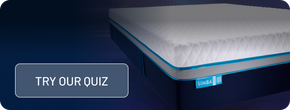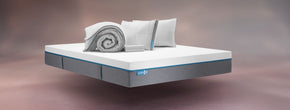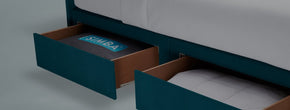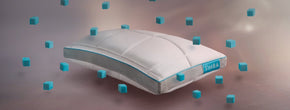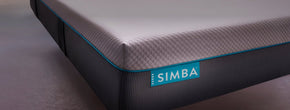8 signs that your mattress is causing you back pain

Back pain is very common and can often feel worse in the morning. While it has many causes, if you’re unable to sleep well, or keep waking up feeling stiff, it’s a good idea to run through the following to check your symptoms are not being caused by your mattress.
Can a mattress cause back pain?
Can a mattress cause back pain? Well, working at a desk all the time, being seated for long hours, constantly looking at a screen, and leading a sedentary lifestyle are common causes of back pain,and a bad mattress can certainly exacerbate an existing problem. While a sore back can have a myriad causes, there are a few tell tale signs that your mattress isn’t helping the situation.
8 Signs Your Mattress Is Causing Back Pain
You wake up in pain
If you wake up in noticeable discomfort then your mattress could be contributing to your back ache. An old or soft mattress may be causing spine misalignment and putting undue pressure on your back.
You feel fine once you’re up and about
Shake it off as soon as you’re up? If morning stretches and an upright position correct the kinks in your back there’s a good chance that your mattress is causing your back pain.
You struggle to find a comfortable position
Tossing around all night is usually an indication that you can’t get comfortable, not staying in a position for very long could be an indication that your mattress is not providing the right support.
You’re sinking
Feel like you’re being swallowed up? If you find it hard to sit up or get up and out of the bed, your mattress is probably too soft to keep your spine in a neutral position throughout the night.
You feel like you’re rolling off the bed
If you feel like you’re going to roll off your mattress, chances are it’s either lost - or never had - adequate edge support.
You’re rolling into the middle
Cosying up a bit too much to your partner? Ending up back to back with your bed fellow? A mattress that sinks in the middle will find it harder to support two people. This might leave you stuck sleeping in a narrow position on one side, or holding onto one edge to stay level.
You feel like you’re sleeping on an ironing board
A mattress that is too hard can force your spine into an unnatural position and add extra pressure to certain points like hips and shoulders. If your mattress creates gaps or space underneath the lumbar area, it’s not supporting your back. A mattress topper can make the difference if you’re finding your mattress too firm.
The Hybrid® Mattress Topper can transform the hardest mattress, and smooth out any lumps and bumps - with four layers of comfort-boosting technology, including a layer of 2,500 Aerocoil® springs, Simbatex® foam comfort layer and supersoft, breathable sleep surface.
Your mattress has had it
Lump, bumps, dips and humps are all signs that your mattress is too old and past its best. The average mattress needs replacing every 8 - 10 years and it’s remarkable how quickly that time can pass.
Simba mattresses are engineered with responsive, advanced layers and edge to edge support comes as standard.
The Simba Aerocoil® micro spring comfort layer consists of tiny titanium cones of comfort that are smaller, and slimmer than traditional springs. These tiny springs offer personalised, full body support.
The multi-zoned foam base uses five separate support zones that adjust as you move. Simba edge lift technology guarantees that no matter where you lie on your Simba mattress, you’ll feel supported, with no rolling off or dipping sides.
For more information, read our guide on the best mattress for back backs.
New mattress back pain
A good quality new mattress shouldn’t cause back pain; they may take a few weeks to bed in, however they should help improve the situation if your old mattress is giving you back pain. Simba’s mattresses are designed to give you the fresher support you need, but if you’re still not sure what to look out for, browse our handy tips on the best mattress for bad back here.
"Great mattress, was having back pain for a while. That’s gone now that I have this mattress"- Calum M, Hybrid® Mattress
"Used to wake up with aches and pains but now wake up feeling refreshed and ready to go"-Sven P, Hybrid® Pro Mattress
